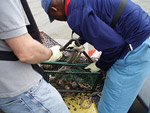
NOAA Tests Shellfish for Eventual Damage Assessment of BP Spill

Dennis Apeti, Ph.D., Mussel Watch scientist, brings up a trawl full of oysters for testing.
In response to the Deepwater Horizon oil spill in the Gulf of Mexico, the National Oceanic and Atmospheric Administration's Mussel Watch program has mobilized three teams of scientists to test shellfish, sediment and water at 60 locations from the Florida Keys to the Brazos River in Texas.
The mission of this Mussel Watch effort is to collect additional baseline data on contamination in strategic areas of the shoreline so that if the oil hits a particular area, new samples can be taken that would reveal the full impact of the spill.
These preliminary samples will be tested for 60 oil-related compounds, including polycyclic aromatic hydrocarbons, known as PAHs. NOAA will use this data as part of the natural resources damage assessment that determines the type and amount of restoration that is required for the Gulf.
Mussel Watch has been monitoring contamination along the nation’s coasts for more than 25 years and has long-term data on the Gulf of Mexico that will be used to assess the effects of the oil spill. The program’s name refers to scientists’ use of shellfish to test for ambient contamination. When shellfish feed, they filter water through their bodies. Any contaminants present in the water concentrate in their tissues. This gives researchers a good idea of what is present in the water and also what is entering the food chain.
Using small boats close to shore, or in some cases wading through water to pry shellfish off of shallow reefs, scientists have been working 12 hours or more each day to collect samples before oiling occurs.
“We are working virtually non-stop to ensure we’re prepared for any scenario,” says Terry McTigue, one of the Mussel Watch researchers. “We have to keep going, making sure we are maintaining the scientific integrity of our samples.”
Oil from the BP spill has a unique chemical “fingerprint” of constituent PAHs and other compounds that should allow Mussel Watch researchers to distinguish contamination from the spill from that coming from other sources.
U.S. Commerce Secretary Gary Locke on May 24 determined there has been a fishery disaster in the Gulf of Mexico due to the economic impact on commercial and recreational fisheries from the ongoing Deepwater Horizon oil spill. The affected area includes the states of Louisiana, Mississippi and Alabama.
Locke said: “The disaster determination will help ensure that the federal government is in a position to mobilize the full range of assistance that fishermen and fishing communities may need.”
Locke made the determination under Section 312(a) of the Magnuson-Stevens Act. The declaration was made in response to requests from Louisiana Gov. Bobby Jindal and Mississippi Gov. Haley Barbour based on the loss of access to many commercial fisheries and the existing and anticipated environmental damage from this unprecedented event.
Since May 2, NOAA closed a portion of federal waters affected by the spill to commercial and recreational fishing. This closure area, which is based on the scientific trajectory of the spill, now includes nearly 20 percent of federal waters in the Gulf of Mexico, largely between Louisiana state waters at the mouth of the Mississippi and the waters off Florida’s Pensacola Bay.
The administration has requested $15 million of supplemental funding as a backstop to address this disaster, as well as $5 million of economic development assistance through the Economic Development Administration. In addition, the administration is requesting unemployment coverage for this disaster, and the Small Business Administration is offering economic injury disaster loans, which can help fishermen and other affected businesses. However, the administration expects that BP and any other responsible parties will cover the full costs of economic damages to and restoration of these fisheries.